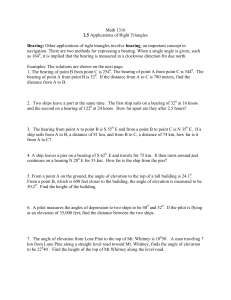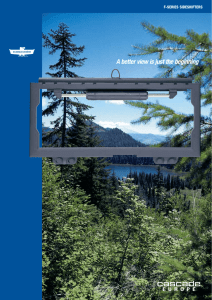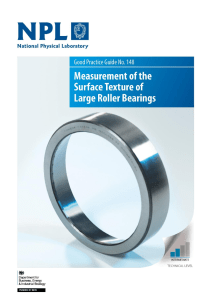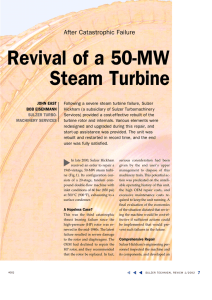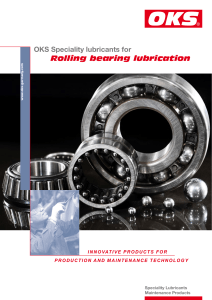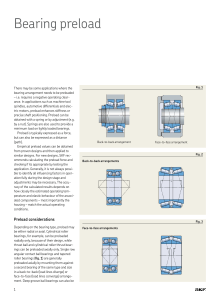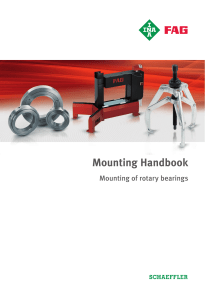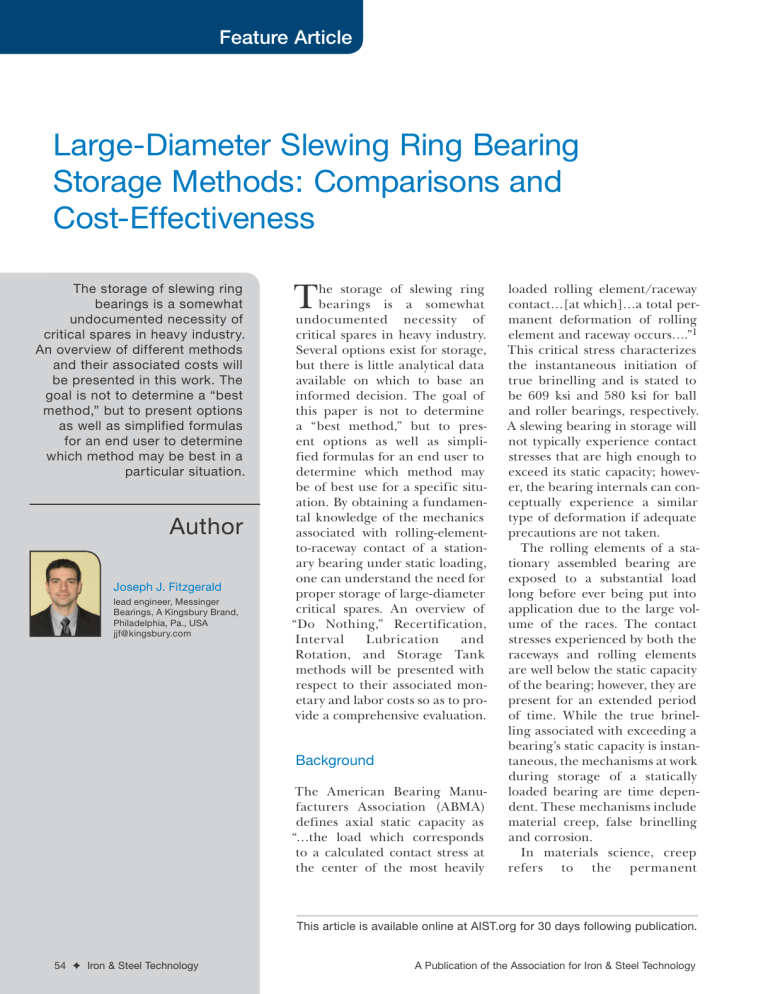
Feature Article Large-Diameter Slewing Ring Bearing Storage Methods: Comparisons and Cost-Effectiveness The storage of slewing ring bearings is a somewhat undocumented necessity of critical spares in heavy industry. An overview of different methods and their associated costs will be presented in this work. The goal is not to determine a “best method,” but to present options as well as simplified formulas for an end user to determine which method may be best in a particular situation. Author Joseph J. Fitzgerald lead engineer, Messinger Bearings, A Kingsbury Brand, Philadelphia, Pa., USA [email protected] T he storage of slewing ring bearings is a somewhat undocumented necessity of critical spares in heavy industry. Several options exist for storage, but there is little analytical data available on which to base an informed decision. The goal of this paper is not to determine a “best method,” but to present options as well as simplified formulas for an end user to determine which method may be of best use for a specific situation. By obtaining a fundamental knowledge of the mechanics associated with rolling-elementto-raceway contact of a stationary bearing under static loading, one can understand the need for proper storage of large-diameter critical spares. An overview of “Do Nothing,” Recertification, Interval Lubrication and Rotation, and Storage Tank methods will be presented with respect to their associated monetary and labor costs so as to provide a comprehensive evaluation. Background The American Bearing Manufacturers Association (ABMA) defines axial static capacity as “…the load which corresponds to a calculated contact stress at the center of the most heavily loaded rolling element/raceway contact…[at which]…a total permanent deformation of rolling element and raceway occurs….”1 This critical stress characterizes the instantaneous initiation of true brinelling and is stated to be 609 ksi and 580 ksi for ball and roller bearings, respectively. A slewing bearing in storage will not typically experience contact stresses that are high enough to exceed its static capacity; however, the bearing internals can conceptually experience a similar type of deformation if adequate precautions are not taken. The rolling elements of a stationary assembled bearing are exposed to a substantial load long before ever being put into application due to the large volume of the races. The contact stresses experienced by both the raceways and rolling elements are well below the static capacity of the bearing; however, they are present for an extended period of time. While the true brinelling associated with exceeding a bearing’s static capacity is instantaneous, the mechanisms at work during storage of a statically loaded bearing are time dependent. These mechanisms include material creep, false brinelling and corrosion. In materials science, creep refers to the permanent This article is available online at aist.org for 30 days following publication. 54 ✦ Iron & Steel Technology A Publication of the Association for Iron & Steel Technology Figure 1 Roller–raceway deformation under a constant static applied load.4 deformation of a solid material due to long-term exposure to static loading that maintains a stress level below the yield strength of the material.2 The phenomenon of creep is heavily influenced by material properties and applied load as well as the duration and temperature of the exposure. Though the effects of creep are significantly amplified with increases in temperature, “…materials such as steel…will creep slightly even at atmospheric temperatures.”3 Bearings stored in one position and subjected to the weight of their own races may develop slight indentations in the roller paths of the raceways and flat spots on the rolling elements (Figure 1). “False brinelling is an adhesive wear mechanism that occurs between rolling elements and raceways when a non-rotating bearing is subjected to external vibration. As the bearing is not rotating, a protective oil film cannot form between the raceways and rolling elements, resulting in metal-to-metal contact. The small, relative motions between these parts under these conditions cause wear, forming grooves on the Figure 2 Lubrication film separation. AIST.org raceways” (Figures 2 and 3).5 This phenomenon is almost always present in heavy industrial storage facilities, as it is not often possible to completely isolate large-diameter bearings in a vibration-free environment. Another phenomenon that must be addressed during the storage of bearings is corrosion. Corrosion is an electrochemical reaction during which atoms from an anode metal release electrons to a cathode when subjected to an electrolyte medium.7 In the case of bearings, this process occurs when steel (i.e., the anode) is exposed to a combination of oxygen and water (i.e., the electrolyte), and ferric hydroxide (i.e., rust) is formed. As the reaction progresses, the steel continues to release iron ions and the surface slowly degrades over time (Figures 4 and 5). Due to the critical nature of bearings, manufacturers typically lubricate and package these components extremely well in order to prevent this oxidation from occurring. Over time, however, the oil contained within grease will degrade and/or evaporate and the effectiveness of the preservative coating becomes compromised. Without adequate protection, critical surfaces are susceptible to corrosion, and therefore the service life of the bearing may be reduced. The mechanisms described are the primary concerns related to long-term slewing ring bearing storage. The plastic deformation and wear experienced by the bearing internals can lead to excessive vibration, increased friction and heat generation, and higher stress concentrations along the roller path once the bearing is put into operation. These phenomena reduce the fatigue life of the critical bearing surfaces and can initiate more serious bearing failure modes, such as spalling or galling (smearing). Ultimately, the improper storage of slewing ring bearings plays a critical role in their premature failure. Figure 3 False brinelling.6 Storage Methods The “Do Nothing” Approach — In some organizations, the storage of critical spares is not deemed a priority. The “Do Nothing” approach, as its name implies, is utilized when a company chooses to store an assembled bearing without taking adequate precautions and then immediately puts the bearing into service without any regard for the current condition of the internal components. If proper monitoring systems are not in place, this can lead to June 2013 ✦ 55 Figure 4 Figure 5 Corrosion of bearing race. 4140 steel corrosion (1,000x magnification).8 unplanned downtime as a result of the bearing’s premature failure. The organization is now faced with unjustified costs associated with underutilized labor, loss of production and the possibility that the bearing will not be reparable due to the extent of the damage incurred. These costs are generally much greater than those associated with proper bearing storage. of bearing storage. The concept is that by lubricating and rotating the bearing, the oil film is being reestablished between the rolling elements and raceway contacts. It also acts to alleviate the time dependency of the critical wear and deformation mechanisms because, upon rotating the bearing, the probability of having roller-to-raceway contact in a previously loaded location is almost nil. The Interval Lubrication and Rotation Method has no direct cost to a company other than labor and lubricant; however, this can be a relatively time-consuming procedure. The criticality of slewing ring bearings necessitates diligence during packaging; thus making it a somewhat difficult task to unwrap, lubricate and rotate, and rewrap the bearing in a satisfactory manner. With proper training and attentiveness, employees can streamline their own methods for completing this procedure efficiently and thus eliminate any need for recertification prior to installation. It should be noted, however, that the longer a bearing is stored, the less cost-effective this method becomes due to the quantity of maintenance instances. Recertification — Recertification is a process in which a bearing that has been stored assembled for a long period of time is sent to a bearing manufacturer in order to “Recertify” that the bearing is in like-new condition prior to its installation in application. In general, there are two levels of recertification that can take place: simple and complex. A simple recertification occurs when a bearing shows only very minimal amounts of deformation and wear. In this case, the roller paths and rolling elements are typically cleaned and polished through a skim grinding operation, and all other components are reused as received. A complex recertification is much more in-depth and takes place when a bearing is received with more extensive damage to the bearing internals. In this instance, the roller paths require grinding, while the rolling elements may require either grinding or replacement, depending on the extent of damage and the configuration of the bearing itself. A complex recertification also typically involves re-establishing the original target bearing clearance. When evaluating the cost of recertification, shipping costs as well as the extent of damage must be taken into consideration. Interval Lubrication and Rotation Method — Many bearing manufacturers will recommend a specific interval of time at which a bearing should be lubricated and rotated in order to avoid the negative effects 56 ✦ Iron & Steel Technology Storage Tanks — A storage tank is a custom item designed and manufactured for a specific bearing or set of bearings. It is used to house a disassembled bearing, which is then submerged in oil to prevent corrosion. Storage tanks typically utilize a staggered configuration or some type of spacer so that none of the components experience metal-to-metal contact on their critical surfaces under load. Though the tanks are often equipped with desiccant filters, it is strongly encouraged that oil samples be analyzed periodically for moisture content. When the results of such an analysis reach an undesirable level, the storage tank must be purged and the oil replaced. This practice A Publication of the Association for Iron & Steel Technology continually ensures the adequate corrosion protection of the bearing components. There is an initial cost associated with the design and manufacture of the storage tank; however, this is a one-time fee that will span several bearing lifetimes (i.e., lifetime of the application), as long as care is taken during loading and unloading. There are also other costs related to this method of storage that must be accounted for. These include the cost of oil utilized to fill the tank, analysis and filtration charges, and other labor costs. Generally, large-diameter slewing ring bearings are shipped assembled. Therefore, plant employees or outside contractors are required to disassemble the bearing and put each component safely into the tank. Prior to installation, the bearing must be removed from the tank and reassembled. There is a certain degree of bearing assembly–related skills and knowledge that must be present in order to perform such tasks in a proper fashion. For this reason, many end users tend to contract outside assistance when performing these tasks. Case Study (Part 1): Steel Mill Turret Bearing Storage (EAF and Caster) In order to assess the different storage methods associated with large-diameter slewing ring bearings, a case study was performed. The focus of the analysis was a three-row roller bearing as stored for both electric arc furnace (EAF) and caster turret applications within a steel mill. For the purpose of this study, the duration of storage has been defined as five years for EAF bearings and 20 years for caster turret bearings. Costs associated with the initial bearing purchase, changeout under normal circumstances, and other items pertinent to all of the storage methods have been omitted, as they cancel each other out and therefore have no relevance on the cost comparison presented. The metrics established to evaluate each storage method include time dependency, cost per bearing stored and total cost over the course of 10 stored bearings. The “Do Nothing” Approach — The “Do Nothing” approach is not a practice recommended by bearing manufacturers because it can drastically reduce the operational life of the bearing. While this may not be a concern in some industries, the high dollar values associated with loss of production in steelmaking warrant that a slewing ring bearing reach the most optimum life possible in application. The potential cost per bearing associated with this method of storage has been calculated to be approximately US$1.4 million for EAF applications and US$1.5 million for caster turrets. These figures include assigned dollar values based on loss of production due to a AIST.org prematurely failed bearing in reasonably good economic times, as well as the assumption that the EAF bearing was salvageable, whereas the caster turret bearing required replacement. The simplified equation used to calculate the cost per bearing stored can be expressed as: Cost( Do Nothing ) = LO + LM + PL + BR + (2 ⋅ FB ) (Eq. 1) (See Appendix 1 for variable definitions) Recertification — Recertification is a practice that is commonly used in heavy industry today. This method allows an end user to guarantee that a bearing is being installed in like-new condition although no maintenance had to be performed on it throughout the duration of storage. The main costs associated with this method stem from the extent of damage incurred during a bearing’s storage. This ultimately defines the complexity of recertification and therefore the costs required to repair the bearing to like-new condition. This case study has determined the cost of storage associated with recertification to be approximately US$50,000 for an EAF bearing and US$100,000 for a caster turret bearing, assuming the related repairs are simple and complex, respectively. The equation associated with this method is defined as: Cost(Recertification ) = BR + (2 ⋅ FB ) (Eq. 2) (see Appendix 1 for variable definitions) Interval Lubrication and Rotation Method — The Interval Lubrication and Rotation Method is often recommended by bearing manufacturers; however, the extent to which it is implemented vastly differs from organization to organization. Because this method requires that maintenance be performed on the stored bearing, this method is explicitly time dependent. This time dependency has a linear correlation; therefore, a caster turret bearing stored four times longer than an EAF bearing will result in a cost that is four times greater as well. In this case study, these values equated to approximately US$21,250 for an EAF application and US$85,000 for a caster turret. The calculation pertinent to the Interval Lubrication and Rotation Method can be expressed by Equation 3: Cost (IL &R ) = (LM + M L ) ⋅ f (Eq. 3) (see Appendix 1 for variable definitions) Storage Tanks — Storage tanks represent one of the most optimum and yet underutilized bearing storage methods in heavy industry today. In many cases, only the upper echelon of maintenance and June 2013 ✦ 57 reliability-centered organizations employ this type of equipment in their PM/PDM programs. The reason for this is that many companies have not justified the initial cost associated with the tank itself. However, the inherent characteristic that is often overlooked is that this one-time fee diminishes with respect to cost per bearing stored, as the expenditure is spread out over the number of bearings for which it is utilized. With respect to the steel industry, the cost per bearing for both EAF and caster turret applications has been calculated to be US$36,250 and US$56,000, respectively, for the first bearing stored and only US$18,250 and US$40,000, respectively, for the tenth bearing stored. The simplified formula used to obtain these trends has been calculated as: M Cost(ST ) = T + LM 1 + M L n + LM 2 + S A + (LM 3 + S F ) ⋅ f + LM 4 (Eq. 4) (see Appendix 1 for variable definitions) Case Study (Part 2): Comparisons and Cost-Effectiveness The equations presented in the preceding section provide a vehicle for calculating comparable performance data between the various storage methods. In utilizing the formulas, certain trends have been observed with respect to the established benchmarking metrics. These metrics include time dependency, cost per bearing stored and total cost over the course of 10 stored bearings. The tables and graphs contained herein have been prepared in order to clarify the results of this case study performed on a specific large-diameter slewing ring bearing in the EAF and caster turret steel mill applications. Time dependency has to do with the change in cost of storage based on the time between bearing changeouts in a particular application. This time dependency has a direct correlation to the “average cost per bearing stored” metric. It has been determined that the “Do Nothing” and Recertification methods do not exhibit time dependency and could thus achieve the same cost despite application because there is no required maintenance to be performed during storage. Alternatively, both the Interval Lubrication and Rotation and Storage Tank methods have a direct time dependency due to the fact that their maintenance is scheduled at specific intervals. This indicates that storage duration and total cost are directly proportional. The time dependence for Interval Lubrication and Rotation can be negated by maintaining uniformity of time between changeouts. Ultimately, this means that the cost per bearing stored remains constant for consecutive bearings utilizing the “Do Nothing,” Recertification, and Interval Lubrication and Rotation methods. The exception to this trend was found to exist in the Storage Tank method, which follows a decaying power law, or more precisely a decaying high-order polynomial expression. The reason that the “cost per bearing stored” metric decreases with every bearing stored in a tank has to do with the tank being a capital expenditure. This means that the initial fee diminishes when spread out over its Figure 6 Figure 7 $10,000,000 Cost per bearing Cost per bearing $10,000,000 $1,000,000 $100,000 $1,000,000 $100,000 $10,000 $10,000 0 2 4 6 8 10 12 Bearing number Do Nothing Recertification Cost per bearing stored (EAF). 58 ✦ Iron & Steel Technology 0 2 4 6 8 10 12 Bearing number Interval Lube & Rotate Do Nothing Interval Lube & Rotate Storage Tank Recertification Storage Tank Cost per bearing stored (caster). A Publication of the Association for Iron & Steel Technology Figure 8 Figure 9 $16,075,000 Cumulative total cost Cumulative total cost $16,020,000 $14,020,000 $12,020,000 $10,020,000 $8,020,000 $6,020,000 $4,020,000 $2,020,000 $14,075,000 $12,075,000 $10,075,000 $8,075,000 $6,075,000 $4,075,000 $2,075,000 $75,000 $20,000 0 2 4 6 8 10 0 12 2 4 6 8 10 12 Bearing number Bearing number Do Nothing Interval Lube & Rotate Do Nothing Interval Lube & Rotate Recertification Storage Tank Recertification Storage Tank Total cost over 10 bearings stored (EAF). Total cost over 10 bearings stored (caster). potential lifetime. These trends can be observed in Figures 6 and 7. Once the effect of time dependency on cost per bearing stored was known, it was simple to apply this data to the concept of total cost over the course of 10 stored bearings. Due to the “constant cost per bearing stored” metric associated with the “Do Nothing,” Recertification, and Interval Lubrication and Rotation methods, it was clear that the total cost over the course of 10 stored bearings would increase linearly. The more ambiguous result was found to characterize the Storage Tank Method. Despite the fact that this method exhibited that of a decaying function with respect to cost per bearing stored, its trend remained linear in terms of total cost over the course of 10 stored bearings. However, due to the inherent decay of the function, this linear trend resulted in the shallowest slope of any of the storage methods evaluated, and thus the most gradual price increase over the course of its utilization. This means that, provided enough time, the storage tank method can become more economical in most applications, despite having a higher initial cost. The results of this analysis can be seen for both EAF and caster turret applications in Figures 8–11. Tables 1 and 2 include summaries of the results obtained through the case study performed on EAF and caster turret applications. A generalized rank for each storage method is also provided. Specific details Figure 11 $600,000 Cumulative total cost Cumulative total cost Figure 10 $500,000 $400,000 $300,000 $200,000 $100,000 $0 0 2 4 6 8 10 12 $1,200,000 $1,000,000 $800,000 $600,000 $400,000 $200,000 $0 0 Bearing number Recertification Interval Lube & Rotate 4 6 8 10 12 Bearing number Storage Tank Total cost over 10 bearings stored (EAF) (“Do Nothing” Method omitted for clarity). AIST.org 2 Recertification Interval Lube & Rotate Storage Tank Total cost over 10 bearings stored (caster) (“Do Nothing” Method omitted for clarity). June 2013 ✦ 59 Table 1 Case Study Results for an EAF Application EAF1 US$/Brg [1 Bearing] US$/Brg [10 Bearings] Total US$ [10 Bearings] Rank3 $1,383,900 $1,383,900 $13,839,000 4 Recertification $56,220 $56,220 $562,200 3 Interval Lube and Rotate $21,200 $21,200 $212,000 2 Storage Tank $36,260 $18,260 $182,600 1 Method Do Nothing2 1 2 3 Assumes minor damage (i.e., Do Nothing = complex repair; Recertification = simple repair) Assumes premature bearing failure Best = 1; Worst = 4; based on total cost over the course of 10 bearings Table 2 Case Study Results for a Caster Turret Application Caster1 US$/Brg [1 Bearing] US$/Brg [10 Bearings] Total US$ [10 Bearings] Rank3 $1,431,400 $1,431,400 $14,314,000 4 Recertification $101,220 $101,220 $1,012,200 3 Interval Lube and Rotate $84,800 $84,800 $848,000 2 Storage Tank $55,980 $37,980 $379,800 1 Method Do Nothing2 1 2 3 Assumes major damage (i.e., Do Nothing = replacement; Recertification = complex repair) Assumes premature bearing failure Best = 1; Worst = 4; based on total cost over the course of 10 bearings pertaining to how the data was calculated are available in Appendix 2. The results of this case study indicate that the Storage Tank Method is the most cost-effective form of storage as long as several bearings will be stored throughout the life of the application. The next best options include the Recertification and Interval Lubrication and Rotation methods, whose ranks will vary depending on several factors, including recertification level (simple or complex) and storage duration based on application (EAF or caster). In all cases, the storage method ranked last is the “Do Nothing” approach, as this is not a recommended practice for critical applications. However, it should be noted that, in some industries where downtime due to unplanned outages is less costly, this option may be a suitable choice. Summary The data analysis performed in this case study provides a generalized rank for each of the storage methods for a specific instance of both EAF and caster turret applications. The practices of different organizations will vary drastically and will therefore have a 60 ✦ Iron & Steel Technology dramatic impact on the final results. There is no “best method” that will remain the optimum choice across all industries and applications. However, by understanding the engineering background and utilizing the designated equations, an end user is equipped with the tools necessary to evaluate his/her own unique situation. An informed decision can then be made as to the practices that should be adopted based on analytical data pertinent to the specific application and cost structure. Acknowledgments The author wishes to thank those who contributed directly or indirectly to the content presented in this paper. These companies include Kingsbury Inc. (Repair and Service Division), MaintenanceReliability Solutions Inc., Nucor Corp., American Chemical Technologies Inc. and Steel Image Inc. The support of each of these organizations has proved to be an integral component in the preparation of this document. A Publication of the Association for Iron & Steel Technology Appendix 1 Table A-1 Variable Definitions by Storage Method “Do Nothing” Variable Cost( Do Nothing ) = LO + LM + PL + BR + (2 ⋅ FB ) Description Variable definition LO Underutilized labor (“stand around”) = # operations employees · # hours · hourly rate LM Cost exceeding planned changeout (extra time) = # maint. employees · (unplanned # hours – typical # hours) · hourly rate PL Cost of lost production = # hours · typical $ amount produced/hour BR Cost of bearing repair/replacement = $ of refurb (complex) or $ of replacement FB Cost of freight = one-way freight $ Cost(Recertification ) = BR + (2 ⋅ FB ) Recertification Variable Description Variable definition BR Cost of bearing recertification = $ of refurb (simple or complex) FB Cost of freight = one-way freight $ Cost (IL &R ) = (LM + M L ) ⋅ f Interval Lubrication and Rotation Variable Description Variable definition LM Labor cost (unwrap/lube/rotate/rewrap) = # maint. employees · # hourly rate · # hours ML Lube cost = $ of lubricant Frequency between installs = (typical years before changeout/MFR recommendation) f Storage Tank Variable M Cost(ST ) = T + LM 1 + M L + LM 2 + S A + (LM 3 + S F ) ⋅ f + LM 4 n Description Variable definition Initial cost of tank = $ of tank Quantity of bearings stored throughout life of application = quantity of bearings LM1 Initial labor cost (bearing disassembly/storage/ fill tank) = # maint. employees · # hours · hourly rate ML Initial oil cost = $ of lubricant LM2 Labor cost (oil sample — 4/year) = 4 · # years · # maint. employees · # hours · hourly rate SA Cost of oil analysis (4/year) = 4 · # years · $ of oil analysis LM3 Labor cost (drain/fill tank as needed) = # employees · # hours · hourly rate SF Filtration cost (filter and refill tank) = $ of filtration MT n f LM4 Frequency of drain/fill = typical # of bad oil sample indications Labor cost (bearing removal/assembly) = ($ of consultant) + (# of maint. employees · # of hours · hourly rate) Note: V ariables are independent from one Storage Method to another (i.e., variable LM has two completely different definitions with respect to the “Do Nothing” approach and Interval Lubrication and Rotation Method.) References 1. ANSI/AFBMA Standard 11, 1990, “Load Ratings and Fatigue Life for Roller Bearings,” American National Standards Institute Inc., New York, N.Y., 1990, www.ansi.org, www.americanbearings. org. 2. S. Kalpakjian and S.R. Schmid, “Fundamentals of the Mechanical Behavior of Materials,” Manufacturing Processes for Engineering Materials, 4th Edition, Prentice Hall, Upper Saddle River, N.J, 2003, p. 55. AIST.org 3. J. Gere, “Tension, Compression and Shear,” Mechanics of Materials, 5th Edition, Brooks/Cole, Pacific Grove, Calif., 2001, p. 23. 4. W.F. Riley and L.D. Sturges, “Friction,” Engineering Mechanics: Statics, 2nd Edition, John Wiley, New York, N.Y., 1996, p. 526, Figure 9–44 (modified). 5. T.A. Harris and M.N. Kotzalas, “Structural Materials of Bearings,” Rolling Bearing Analysis, 5th Edition, CRC/Taylor and Francis, Boca Raton, Fla., 2007, p. 320. June 2013 ✦ 61 Appendix 2 Table A-2 Storage Method Costing Calculation Examples (in U.S. dollars) “Do Nothing” Variable Cost( Do Nothing ) = LO + LM + PL + BR + (2 ⋅ FB ) Variable definition EAF Caster EAF Caster LO = (70) operations employees · (24) hours · $47.50/hour = $79,800 $79,800 $79,800 $79,800 LM = (8) maint. employees · [(24) unplanned hours – 18 typical hours] · $60/hour = $2,880 $2,880 $2,880 $2,880 PL = (24) hours · $50,000/hour = $1,200,000 $1,200,000 $1,200,000 $1,200,000 BR EAF = $85,000 for refurb. (complex) or caster = $180,000 for replacement = $85,000 $180,000 $85,000 $180,000 FB = $8,110 one-way freight = $8,110 $1,383,900 $8,110 $1,478,900 $8,110 $1,383,900 $8,110 $1,478,900 Cost(Do Nothing)/Brg[(1)Brg] Recertification Variable Cost(Do Nothing)/Brg[(10)Brgs] Cost(Recertification ) = BR + (2 ⋅ FB ) Variable definition EAF Caster EAF Caster BR EAF = $40,000 for refurb. (simple) or caster = $85,000 for refurb. (complex) = $40,000 $85,000 $40,000 $85,000 FB = $8,110 one-way freight Interval Lubrication and Rotation Variable $8,110 $8,110 $56,220 $101,220 Cost(Recert.)/Brg[(1)Brg] $8,110 $8,110 $56,220 $101,220 Cost(Recert.)/Brg[(10)Brgs] Cost (IL &R ) = (LM + M L ) ⋅ f Variable definition EAF Caster EAF Caster LM = (2) maint. employees · (8) hours · $60/hour $960 $960 $960 $960 ML = $100 for lubricant = $100 $100 $100 $100 EAF = (5) years/quarterly MFR recommended interval or caster = (20) years/quarterly = 20 80 20 80 f $21,200 $84,800 Cost(IL&R)/Brg[(1)Brg] Storage Tank $21,200 $84,800 Cost(IL&R)/Brg[(10)Brgs] M Cost(ST ) = T + LM 1 + M L + LM 2 + S A + (LM 3 + S F ) ⋅ f + LM 4 n Variable Variable definition EAF Caster EAF Caster MT = $20,000 of tank = $20,000 $20,000 $20,000 $20,000 n = quantity of bearings = (1, ... , 10, ... ) = 1 1 10 10 = (3) maint. employees · (8) hours · $60/hour $1,440 $1,440 $1,440 $1,440 ML = $5,650 for lubricant = $5,650 $5,650 $5,650 $5,650 LM2 = 4 · [(5) years EAF or (20) years for caster] · (1) maint. employee · (1) hour · $60/hour = $1,200 $4,800 $1,200 $4,800 SA = 4 · [(5) years EAF or (20) years for caster] · $150 for oil analysis = $3,000 $12,000 $3,000 $12,000 LM3 = (2) maint. employees · (2.333) hours · $60/hour = $280 $280 $280 $280 SF $1,500 for oil filtration = $1,500 $1,500 $1,500 $1,500 f = typical # of bad oil sample indications = 1/(3–4 years) = 1 5 1 5 LM4 = ($1,750 consultant) + [(3) maint. employees · (8) hours · $60/hour] = $3,190 $3,190 $3,190 $3,190 LM1 $36,260 $55,980 Cost(ST)/Brg[(1)Brg] $18,260 $37,980 Cost(ST)/Brg[(10)Brgs] Note: V ariables are independent from one Storage Method to another (i.e., variable LM has two completely different definitions with respect to the “Do Nothing” approach and Interval Lubrication and Rotation Method. Brg = Bearing 62 ✦ Iron & Steel Technology A Publication of the Association for Iron & Steel Technology 6. D. Manney, “False Brinelling,” Bearing Failure Part III: False Brinelling, Misalignment, Slippage Tracks, 30 May 2011, accessed 1 February 2012, www.lselectric.com/wordpress/2011/05/30/bearing-failure-part-iii-false-brinelling-misalignment-slippage-tracks. 7. T.L. Anderson, “Environmentally Assisted Cracking in Metals,” Fracture Mechanics: Fundamentals and Applications, 3rd Edition, Taylor and Francis, Boca Raton, Fla., 2005, pp. 511– 514. 8. S. Turcott, “4140 Steel Corrosion (1,000x Magnification),” Corrosion, Steel Image of the Month: The Art of Metallurgy, Steel Image Inc., Flamborough, Ont., Canada, 31 August 2011, accessed 21 December 2011, www.steelimage.ca. F Nominate this paper Did you find this article to be of significant relevance to the advancement of steel technology? If so, please consider nominating it for the AIST Hunt-Kelly Outstanding Paper Award at AIST.org/huntkelly. This paper was presented at AISTech 2012 — The Iron & Steel Technology Conference and Exposition, Atlanta, Ga., and published in the Conference Proceedings. AIST.org June 2013 ✦ 63
